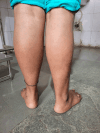Autosomal Recessive Becker's Form of Myotonia Congenita in Indian Families
- PMID: 40535402
- PMCID: PMC12176253
- DOI: 10.7759/cureus.84373
Autosomal Recessive Becker's Form of Myotonia Congenita in Indian Families
Abstract
Myotonia congenita (MC), a rare inherited disease, is caused by variations in the skeletal muscle chloride voltage-gated channel one gene (CLCN1) and is characterized by symptoms of myotonia and muscle hypertrophy. We present a case report of two female patients aged nine and 10, from Andhra Pradesh, India, with a history of parental consanguinity, hypertrophy of arm and calf muscles, permanent weakness, and proximal muscle weakness. Patients were diagnosed with Becker's form of MC after genetic testing that reported the mutation c.1667T >A (p.lle556Asn) in exon 15 of the CLCN1, which is a pathogenic variant. Treatment with mexiletine showed improvement in the condition of patients. Because of its inherent nature, parents were given genetic counseling and the choice of antenatal diagnosis for upcoming pregnancies.
Keywords: becker’s disease; clcn1 gene; mutation; myotonia congenita; non-dystrophic myotonia.
Copyright © 2025, Krovvidi et al.
Conflict of interest statement
Human subjects: Consent for treatment and open access publication was obtained or waived by all participants in this study. Institutional Ethics Committee of NRI Medical College and General Hospital issued approval IEC2025 Case Report 03/CK. The Institutional Ethical Committee waived the approval as no clinical trial or experimentation was conducted. Written consent of the participant persons was obtained. Conflicts of interest: In compliance with the ICMJE uniform disclosure form, all authors declare the following: Payment/services info: All authors have declared that no financial support was received from any organization for the submitted work. Financial relationships: All authors have declared that they have no financial relationships at present or within the previous three years with any organizations that might have an interest in the submitted work. Other relationships: All authors have declared that there are no other relationships or activities that could appear to have influenced the submitted work.
Figures



Similar articles
-
Clinical and genetic analysis and literature review of children with myotonia congenita due to CLCN1 mutations.Ital J Pediatr. 2025 Jun 9;51(1):183. doi: 10.1186/s13052-025-02028-1. Ital J Pediatr. 2025. PMID: 40490814 Free PMC article. Review.
-
Uncovering the CLCN1 Y150* nonsense variant in myotonia congenita: genetic evidence from segregation analysis.Acta Neurol Belg. 2025 Aug 9. doi: 10.1007/s13760-025-02861-5. Online ahead of print. Acta Neurol Belg. 2025. PMID: 40782174
-
First Two Case Reports of Becker's Type Myotonia Congenita in Colombia: Clinical and Genetic Features.Appl Clin Genet. 2021 Dec 16;14:473-479. doi: 10.2147/TACG.S323559. eCollection 2021. Appl Clin Genet. 2021. PMID: 34938096 Free PMC article.
-
Mutations in the human skeletal muscle chloride channel gene (CLCN1) associated with dominant and recessive myotonia congenita.Neurology. 1996 Oct;47(4):993-8. doi: 10.1212/wnl.47.4.993. Neurology. 1996. PMID: 8857733
-
Congenital myotonia: a review of twenty cases and a new splice-site mutation in the CLCN1 gene.Turk J Pediatr. 2020;62(3):450-460. doi: 10.24953/turkjped.2020.03.012. Turk J Pediatr. 2020. PMID: 32558419 Review.
References
-
- Transient weakness and altered membrane characteristic in recessive generalized myotonia (Becker) Rüdel R, Ricker K, Lehmann-Horn F. Muscle Nerve. 1988;11:202–211. - PubMed
-
- Myotonia congenita. Gutmann L, Phillips LH 2nd. Semin Neurol. 1991;11:244–248. - PubMed
-
- Chapter 2 myotonia congenita. Lossin C, George AL Jr. Adv Genet. 2008;63:25–55. - PubMed
-
- Novel mutations in the muscle chloride channel CLCN1 gene causing myotonia congenita in Spanish families. de Diego C, Gámez J, Plassart-Schiess E, et al. J Neurol. 1999;246:825–829. - PubMed
-
- A population-based epidemiologic study of adult neuromuscular disease in the Republic of Ireland. Lefter S, Hardiman O, Ryan AM. Neurology. 2017;88:304–313. - PubMed
Publication types
LinkOut - more resources
Full Text Sources
